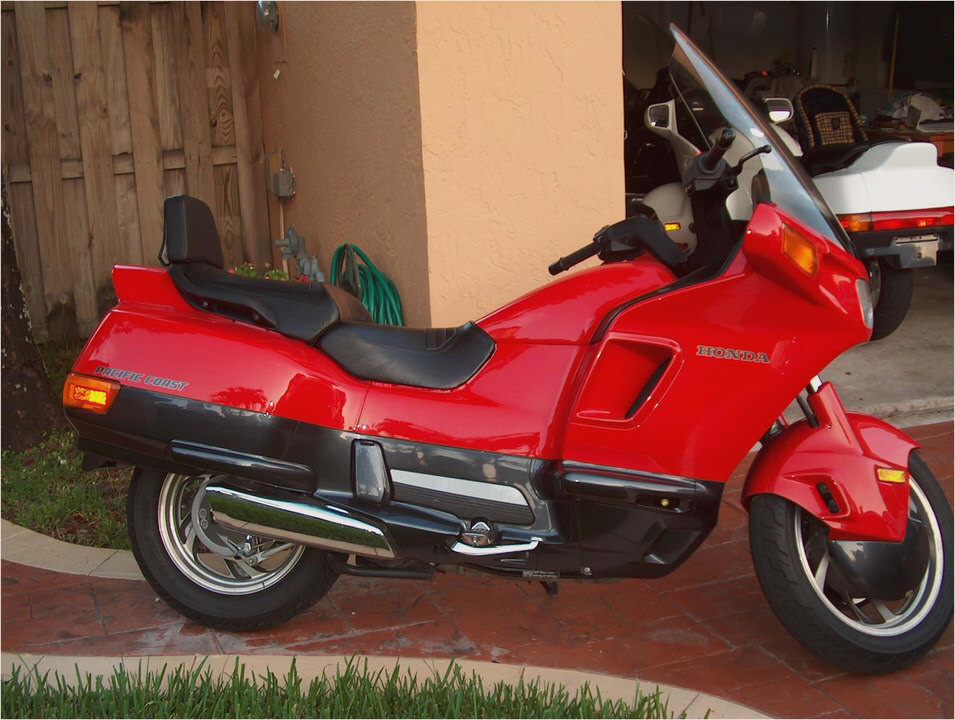
The Honda PC800 Pacific Coast: Best Motorcycle I’ve Owned
The Honda PC800 Pacific Coast was released to the public in 1989. Its development was a result of a joint effort between American Honda and its parent company in Japan. The goal in offering this motorcycle was to attract new riders to motorcycling by offering a machine equipped with many features that would be attractive to first time motorcyclists.
The Pacific Coast offered new riders a motorcycle with a low seating position so that riders of both short and tall stature would be comfortable on it. Honda placed the fuel tank under the seat so that the center of gravity would be low, making the bike easy to balance and manage for new riders. The rear view mirrors were cleverly placed on the body of the bike below the handlebars which gave excellent rear visibility.
These mirrors were designed to break away in the event the bike fell over, creating minimal damage to the mirrors which could then easily be re-inserted in their original position. The mirrors also contained the turn signals which provided excellent visibility to other traffic.
Another feature that Honda designed to minimize damage was to build front and rear crash bars hidden behind separate body panels in the lower front and rear of each side of the bike. If the bike was tipped over and the body panels covering the crash bars were damaged the panels were easily replaceable and saved the owners the expense of replacing much larger body panel sections.
For the further convenience of new riders Honda used a shaft drive to provide power to the rear wheel rather than a chain. A drive chain requires frequent lubrication and occasional adjustment. A shaft drive merely requires simple fluid replacement at long intervals.
In a further effort to make maintenance easier for the new riders the engine was designed to use hydraulic valves similar to what is found in automobiles. Most motorcycles use adjustable valves which require special skills to adjust at regular intervals. Honda used the two cylinder V-Twin configuration engine from it’s successful 750cc Shadow model cruiser bike and increased the displacement from 750cc to 800cc for more responsiveness.
Honda then took the additional and quite unusual step of encapsulating the engine in sound insulating polystyrene foam to make it quieter and more pleasant for the first time riders.
The styling of the Pacific Coast is best described as touring style for while it had a relatively short range of about 160-180 miles per tank of fuel (40-45mpg), it features a windshield and the most unusual storage area ever offered on a motorcycle. By unlocking the small door at the base of what looked like the fuel tank (really a cover for the air filter.
Remember the fuel tank is under the seat.) one could fill the fuel tank, adjust the engine idle speed by turning a knob or pull a release lever that allowed the entire rear section of the top of the bike including the passenger seat to open providing enough room for a full face helmet to be stored on each side of this trunk with room to spare. Even today, 22 years after the release of the Pacific Coast people are still amazed at the creativity Honda used to provide this storage area.
Riding the Honda Pacific Coast is simply a pleasure. Because it was designed to be easy for new riders to ride experienced riders find it a joy to ride. Without exception all of the riders that have ridden the Pacific Coast have expressed their surprise at what a pleasant machine it is to ride both for daily commuting and touring. Many riders after having ridden our bike have gone out and found one for themselves!
It cruises comfortably on interstate highways or on back roads. It has very few shortcomings and has a history of very few mechanical problems. Honda introduced the bike in 1989 offering it in an off white color in 1989 and 1990.
It did not sell well for Honda in the USA because American Honda did not invest in sufficient marketing of it which is why it was frequently overlooked by the public. It was next offered in 1994 in a red or black color and again did not sell in large volume for the same reason. Honda brought the Pacific Coast back again in 1997 in red only and discontinued it after the 1998 model year.
The major changes to the bike occurred before the 1994 model was released. Honda made several hundred minor adjustments to the original design to make the bike smoother and quieter and was quite successful to that end. The 1994 and newer models were a significant improvement in rider comfort and noise level over the original version.
The Honda Pacific Coast now enjoys an almost cult like status and has spawned several owners groups. It’s the sort of bike that even with 30 to 40k miles on it is still a great machine to have. Expect to pay $2500 to $4500 for one depending on the condition and the mileage.
The Contributor has no connection to nor was paid by the brand or product described in this content.
- Honda CBR900RR – Wikipedia, the free encyclopedia
- 2004 Honda CBR 1000 RR –
- Honda NSR Hornet 125 – Page 10
- Honda ST1300 – Wikipedia, the free encyclopedia
- 2002 Honda CBR 954 RR – Pictures, gallery, videos, reviews! Check it out!…

